Journal Special Issue
Spatial Inequality and Development
Many developing and transition countries have considerable regional variation in average household income, poverty, and in health and educational status. National human development indicators can therefore mislead policy-makers when large regional disparities exist. This project will investigate the size and determinants of regional disparities in a representative selection of countries. It will use indicators such as poverty incidence and depth, within-region income inequality, human development, and gender indicators to better understand why some regions fall behind in the development process.
 Join the network
Join the network